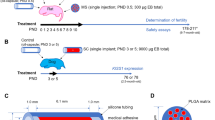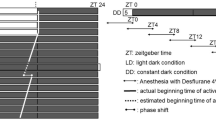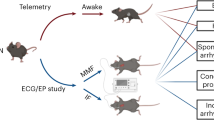Abstract
Although commonly used to induce anesthesia in rodents, the effective dose of tribromoethanol is associated with various side effects. The authors previously found that a tribromoethanol-medetomidine combination reduced the dose of tribromoethanol necessary for effective anesthesia in male Sprague-Dawley rats, an effect reversible by atipamezole. Here, the authors focus on the effect of this anesthetic combination in female Sprague-Dawley rats, its effects on their estrous cycles, and its efficacy at low sex hormone levels. Their results suggest that the anesthetic combination is effective in female rats, does not affect their estrous cycles, and works even when hormone levels are low, such as after ovariectomy.
Similar content being viewed by others
Main
Tribromoethanol (TBE), commonly used as a rodent anesthetic, offers several advantages over other anesthetic drugs, including ease of administration, rapid induction, good muscle relaxation, and fast recovery1. In addition, TBE is not a federally controlled drug. TBE, however, is reported to have many side effects at the effective dose and repeated use may result in intestinal ileus, liver necrosis, peritonitis, and death2,3,4,5. Some of these adverse effects may be attributable to the purity of the TBE used or the preparation and storage methods applied2,6. Recently, our laboratory reported that the combination of TBE and medetomidine (MT; an alpha2-adrenergic agonist and a widely known analgesic) in male Sprague-Dawley rats resulted in reliable anesthesia using a lower TBE dose. This anesthetic combination is also easily reversible by atipamezole, an alpha2-adrenergic antagonist7.
The normal estrous cycle for Sprague-Dawley rats lasts 4–5 days8,9,10, but is sensitive to various conditions, such as stress11 or anesthesia12. Having previously shown that a TBE-MT combination is effective in male rats7, we extended the investigation to determine the efficacy of the drug combination in female rats and test whether it would interfere with the estrous cycle. We also monitored the effectiveness of the TBE-MT combination in ovariectomized rats (where estrogen and progesterone levels are significantly lower13,14,15).
Methods
Animals
We housed female Sprague-Dawley rats (150–250 g) obtained from Charles River Laboratories (Portage, MI) in groups of three in solid-bottom polysulfone-resin cages (model: PC10198HT; Allentown, Inc., Allentown, NJ) with aspen chip bedding (El-Mel, Inc., St. Louis, MO). We maintained the rat room at 20.0–22.2 °C on a 12:12-h light-dark cycle. Vendor records indicated that the animals were free of major bacterial, viral, and parasitic pathogens. We provided food (KayTee Forti-Diet, KayTee Products, Inc., Chilton, WI) and tap water by bottle ad libitum.
Upon arrival, we caged the female rats and colored their tails. We allowed the animals to acclimate for one full day before conducting the estrous studies. On the eighth day, we used the rats in the anesthesia experiment. Each group included 7–9 rats to ensure that there would be at least six animals with regular estrous cycles. Since all the rats cycled normally, we included them all in the study. The St. Louis Community College Institutional Animal Care and Use Committee approved the animal care and experimental procedures.
Vaginal lavage to study estrous cycle in rats
We consistently obtained vaginal lavage between 8:00 am and 10:00 am by manually holding the animal upside down and introducing a dropper (1-ml rubber nipple, overall length 3.5 inches) filled with 0.2 ml normal saline9,16. Once a few drops of saline were introduced into the vagina, we collected the fluid using the dropper and placed it on a slide. The cell type collected was then studied under a light microscope (40× objective lens).
Evaluating the estrous cycles
The estrous cycle in female rats is characterized by the following four stages: proestrus, estrus, diestrus 1, and diestrus 2. Since proestrus is the shortest period (about 12 hours), it might be missed with 24-hour vaginal examinations. The characterization of each phase is based on the proportions of epithelial cells, cornified cells, and leukocytes observed in the vaginal lavage8,16,17. In summary, the proestrus stage shows nucleated cells, whereas in estrus, the cells are nonnucleated or cornified. Diestrus 1 shows leukocytes in larger numbers than in diestrus 2. In cases when cell type was uncertain, we employed a second evaluator to study the slide. All rats demonstrated regular 4–5-day estrous cycles and were used in the experiments after eight days of estrous-cycle recording.
Drug preparation
The preparation of TBE, MT, and atipamezole has been described in detail in Gopalan et al.7. Briefly, we prepared the stock solution of TBE (1 g/ml) using 5 g of TBE (T48402, Sigma Aldrich, St. Louis, MO) dissolved in 5 ml of butanol (tertiary amyl alcohol, 240486, Sigma Aldrich). As TBE is light-sensitive, we made every effort to avoid exposing this compound to light by storing it at 4 °C in a dark bottle covered with aluminum foil. Proper storage of TBE is critical because the compound's breakdown products can be lethal when stored for a long period of time2,6. We prepared fresh dilutions of TBE (150 mg/kg) from the stock solution and the appropriate doses of MT (0.5 mg/kg) and atipamezole (1 mg/kg) on the day of the experiment using physiological saline. We gave separate intraperitoneal injections of TBE, MT, and atipamezole in volumes of 0.35–0.55 ml.
Statistical analyses
The induction time, reversal time, and recovery time of the intact group were compared with the same in the ovariectomized group using Student's t-test (Fig. 1). All results are given as mean ± standard deviation. We considered differences significant when P < 0.05.
Study 1: Effect of TBE-MT on the estrous cycle
In this experiment, we used nine rats in each group to study the effect of the TBE-MT combination anesthetic on the estrous cycle. Group 1 received TBE (150 mg/kg) and MT (0.5 mg/kg) with a saline injection 10 min after anesthesia. Group 2 received the same dosage of TBE-MT with an atipamezole injection 10 min after anesthesia to reverse the anesthetic effect. We defined induction time as the time from TBE and MT injections to the time when the animal lost its righting and palpebral reflexes (indicating loss of consciousness). We defined anesthetic duration as the time from when the animal lost consciousness and responsiveness to the toe-pinch reflex until the time that it regained these reflexes. Finally, we defined recovery time as the time from when the animal regained palpebral and toe-pinch reflexes to the time when the rat was able to right itself and ambulate7.
Study 2: Effect of TBE-MT in ovariectomized rats
In this study, we used 16 rats divided into two groups. We tested all rats for normal estrous cycles from the day of arrival to the day of the experiment (Tables 1, 2). Group 1 comprised seven ovariectomized rats, while Group 2 comprised nine intact rats.
Ovariectomy procedure. We selected rats for ovariectomy randomly and not based on a specific stage of the estrous cycle. They were bilaterally ovariectomized9 under aseptic conditions using the same TBE (150 mg/kg)-MT (0.5 mg/kg) combination anesthesia. We shaved a small area (∼0.5 inch) caudal to the posterior border of the rib cage and cleaned it with cotton swabs dipped in 70% alcohol. We then made a small incision through the skin and muscle layers. We separated the ovary from the blood vessels by tying a knot around the ovary using a sterile nylon suture; the ovary then detached from the body cavity. We closed the layers of the incision using a suture for the muscle layers and wound clips for the skin.
At the end of the surgery, we gave the animals atipamezole (1 mg/kg) to reverse the effect of anesthesia. We allowed the rats to recover from the surgery for a week. This helped to decrease the residual ovarian hormone levels in the system before retesting the effectiveness of the anesthesia13,15. We recorded the estrous cycles daily until the day of the experiment (Table 2). We found the cycles to be in the diestrus stage for all the ovariectomized rats, as expected. The focus of this experiment was to learn if the anesthetic combination would work when sex hormone levels were low, such as in the case of ovariectomized rats. Therefore, we did not make hormone measurements as such.
On the day of the experiment, we gave Groups 1 and 2 TBE (150 mg/kg)-MT (0.5 mg/kg) with an atipamezole injection 10 min after the induction of anesthesia to reverse the anesthetic effect. Table 1 summarizes the protocol used in both studies. The times of induction, onset of anesthesia, duration of anesthesia, and recovery were recorded as described above.
Results
Table 2 summarizes the estrous cycles of all the rats included in the studies. The rats that underwent ovariectomy remained in diestrus whereas the other animals had 4–5-day cycles.
Table 3 shows the effect of the TBE-MT combination on cycling female rats. Rats in Group 1 received 150 mg/kg TBE with 0.5 mg/kg MT. We gave them saline 10 min after anesthesia. The induction time for this group was 2.3±2.9 min. These rats had an anesthetic duration of 66.8±15.8 min and took 79.4±25.3 min to recover. Rats in Group 2 received 150 mg/kg TBE with 0.5mg/kg MT. We administered atipamezole (1 mg/kg) 10 min after the rat was anesthetized. The induction time for this group was 2.7±1 min. With atipamezole treatment, the reversal time was 2.3±1 min and the recovery time was 0.9±1.2 min. Post-experimental estrous cycle records show that the animals continued from one stage to the next without any disruption in their cycling.
In the second experiment, both Group 1 (intact) and Group 2 (1 week postovariectomy) received 150 mg/kg TBE with 0.5 mg/kg MT, and 1mg/kg atipamezole 10 min after the rat was anesthetized. The average induction time for Group 1 was 2.1±1.8 min, reversal time was 1.1±0.4 min, and recovery time was 0.8±0.6 min. Group 2 had the induction time of 2.1±0.7 min, recovery time 0.5±0.4 min, and reversal time 1.8±0.6 min, which was statistically significant compared to the reversal time for Group 1 (Fig. 1).
Discussion
From these results, it is evident that the TBE-MT combination, proven as an effective and reversible anesthetic in male rats7, can also be used in female rats. The anesthetic combination was associated with a rapid induction time, along with a relatively long anesthetic duration (similar to what was seen in male rats). The results of the study of estrous cycles before and after the use of TBE-MT showed no difference in cycling, and the use of atipamezole to reverse the effect of the anesthetic also did not interfere with the estrous cycle. Ovarian cycle synchrony, which is common in humans18, was not evident in the estrous cycle study of the rats during the period tested.
Similarly, decreased levels of reproductive hormones in female rats (such as after ovariectomy) had no significant effect on the induction time. It is interesting to note, however, that the reversal time in the ovariectomized rats was significantly longer than in the control group. A reduction in estrogen and progesterone would seemingly facilitate anesthetic potency in animals and humans. This could be due to increased progesterone and progesterone-metabolite levels, which are potent positive allosteric modulators of gamma-aminobutyric acid type A receptors19,20. We anesthetized the animals using TBE-MT more than once during these studies and their response to anesthesia each time was similar to the initial response, indicating that the rats did not develop anesthetic resistance.
Although gender differences were not tested in this study, a comparison with our previous study on males indicates that the induction time (1–2 min) and the anesthetic duration (76 min in males, 67 min in females) were similar. The recovery time, however, was longer in the female rats (79 min) compared to that of the males (45 min).
Although TBE is a controversial anesthetic and its preparation is difficult, our studies show that a lower dose of TBE and a careful preparation technique can offer advantages, especially because it is effective in female rats, whose hormone levels fluctuate. Additionally, since TBE is an injectable anesthetic, one can avoid the cost of equipment needed for inhalant anesthesia. Moreover, TBE is not a federally controlled drug.
In conclusion, these studies suggest that the TBE-MT combination anesthetic can be used in female Sprague-Dawley rats. The combination has proven to be effective and is not compromised by changes in hormone levels. Furthermore, these studies suggest that the anesthetic does not interfere with normal estrous cycles.
References
Papaioannou, V.E. & Fox, J.G. Efficacy of tribromoethanol anesthesia in mice. Lab. Anim. Sci. 43(2), 189–192 (1993).
Lieggi, C. et al. Efficacy and safety of stored and newly prepared tribromoethanol in ICR mice. Contemp. Top. Lab. Anim. Sci. 44(1), 17–22 (2005).
Reid, W.C., Carmichael, K.P., Srinivas, S. & Bryant, J. Pathologic changes associated with use of tribromoethanol (Avertin) in the Sprague Dawley rat. Lab. Anim. Sci. 49(6), 665–667 (1999).
Thompson, J.S. et al. Early effects of tribromoethanol, ketamine/xylazine, pentobarbital, and isoflurane anesthesia on hepatic and lymphoid tissue in ICR mice. Comp. Med. 52(1), 63–67 (2002).
Zeller, W., Meier, G., Burki, K. & Panoussis, B. Adverse effects of tribromoethanol as used in the production of transgenic mice. Lab. Anim. 32(4), 407–413 (1998).
Lieggi, C.C. et al. An evaluation of preparation methods and storage conditions of tribromoethanol. Contemp. Top. Lab. Anim. Sci. 44(1), 11–16 (2005).
Gopalan, C., Hegade, G.M., Bay, T.N., Brown, S.R. & Talcott, M.R. Tribromoethanol-medetomidine combination provides a safe and reversible anesthetic effect in Sprague-Dawley rats. Contemp. Top. Lab. Anim. Sci. 44(1), 7–10 (2005).
Gorbman, A., Dickhoff, W.W., Vigna, S.R., Clark, N.B. & Ralph, C.L. in Comparative Endocrinology 493–497 (John Wiley & Sons Inc., New York, NY, 1983).
Hubscher, C.H., Brooks, D.L. & Johnson, J.R. A quantitative method for assessing stages of the rat estrous cycle. Biotech. Histochem. 80(2), 79–87 (2005).
Takeo, Y. Influence of continuous illumination on estrous cycle of rats: time course of changes in levels of gonadotrophins and ovarian steroids until occurrence of persistent estrus. Neuroendocrinology 39(2), 97–104 (1984).
Caruso, J.M., Deitch, E.A., Xu, D.Z., Lu, Q. & Dayal, S.D. Gut injury and gut-induced lung injury after trauma hemorrhagic shock is gender and estrus cycle specific in the rat. J. Trauma 55(3), 531–539 (2003).
Shirley, B. Effect of decreased estrogen activity on induction of ovulation in barbital-treated rat. Proc. Okla. Acad. Sci. 59, 76–81 (1979).
Camp, P. & Barraclough, C.A. Correlation of luteinizing hormone surges with estrogen nuclear and progestin cytosol receptors in the hypothalamus and pituitary gland. Neuroendocrinology 40(1), 45–53 (1985).
Micevych, P. et al. The luteinizing hormone surge is preceded by an estrogen-induced increase of hypothalamic progesterone in ovariectomized and adrenalectomized rats. Neuroendocrinology 78(1), 29–35 (2003).
Wise, P.M. & Ratner, A. Effect of ovariectomy on plasma LH, FSH, estradiol, and progesterone and medial basal hypothalamic LHRH concentrations old and young rats. Neuroendocrinology 30(1), 15–19 (1980).
Marcondes, F.K., Bianchi, F.J. & Tanno, A.P. Determination of the estrous cycle phases of rats: some helpful considerations. Braz. J. Biol. 62(4), 609–614 (2002).
Freeman, M.E. in The Physiology of Reproduction, Vol. II, 2nd Edn. (eds. Knobil, E. & Neill, J.D.) 613–615 (Raven Press, New York, NY, 1994).
Weller, L. & Weller, A. Human menstrual synchrony: a critical assessment. Neurosci. Biobehav. Rev. 17(4), 427–439 (1993).
Erden, V. et al. Increased progesterone production during the luteal phase of menstruation may decrease anesthetic requirement. Anesth. Analg. 101(4), 1007–1011 (2005).
Gintzler, A.R. & Liu, N.J. The maternal spinal cord: biochemical and physiological correlates of steroid-activated antinociceptive processes. Prog. Brain Res. 133, 83–97 (2001).
Acknowledgements
The authors thank Michael Talcott (Division of Comparative Medicine, Washington University School of Medicine) for advice, Charles River Laboratories for the animals, and Cathy Adams for assistance. This study was supported by a grant from the Human Anatomy and Physiology Society. The library support of Janice Hovis and the technical support of Thomas J. Philips are also appreciated. Theresa Hacker and Danielle Binion participated in the revision of this manuscript.
Author information
Authors and Affiliations
Corresponding author
Ethics declarations
Competing interests
The authors declare no competing financial interests.
Rights and permissions
About this article
Cite this article
Gopalan, C., Simmons, A., Mungal, G. et al. Effects of tribromoethanol-medetomidine combination on cycling and ovariectomized Sprague-Dawley rats. Lab Anim 36, 36–40 (2007). https://doi.org/10.1038/laban0707-36
Received:
Accepted:
Issue Date:
DOI: https://doi.org/10.1038/laban0707-36




